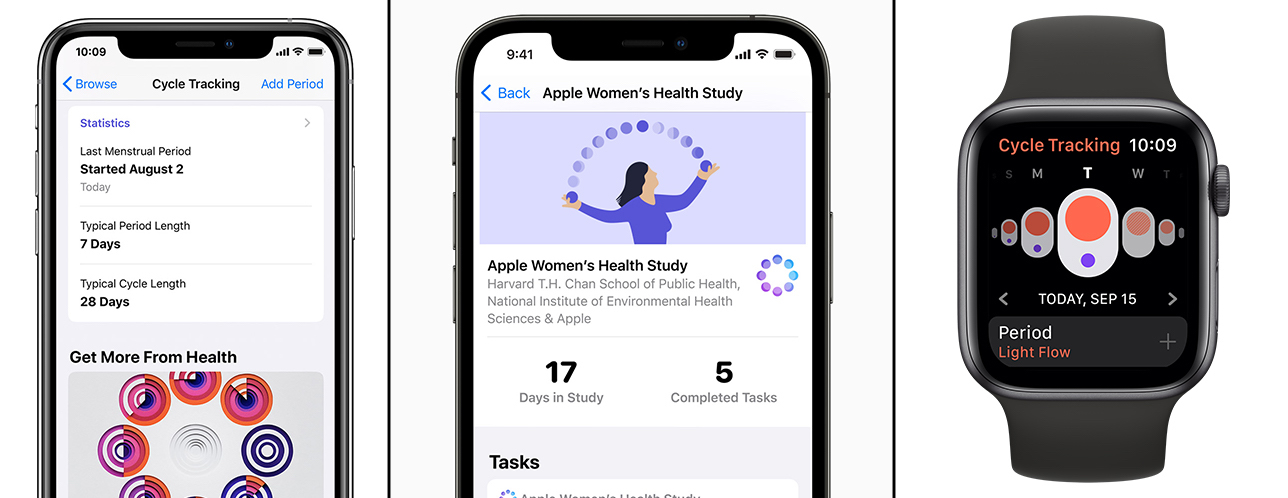It can be quite difficult sometimes to track the various health concerns that are unique to women, especially menstrual health. For most of us, the idea of menstrual health is simply the dreaded few days of uncomfortable inconvenience that comes in a 28-day cycle, and nothing more — even when we may occasionally experience irregular or abnormal periods, we tend not to let that concern us, chalking it all up to the consequence of stress.
.

However, the neglect to address these minor issues has the potential to lead to major health threats. In an effort to get more women talking and understanding their own menstrual health, Apple has partnered with the Harvard T.H. Chan School of Public Health to assemble an Apple’s Women Health Study team to bring more insight into this under-researched topic.
APPLE WOMEN’S HEALTH STUDY
Headed by principal investigator, Assistant Professor Dr. Shruthi Mahalingaiah, the aim of the study is to “highlight that period symptoms are a shared experience around menstrual health, across varying ages and ethnicities”, and it is important to create a larger foundational data set on this topic that can eventually become the standard for understanding menstruation and menstrual health, and inspire new areas of research across women’s health.
.

Through the US-only Research app, the Apple Women’s Health Study continuously invites women across the US to contribute to the research through their iPhones and/or Apple Watches, where they collect a comprehensive set of menstrual cycle tracking and other related health data, alongside participant surveys, from female individuals across different races and various stages of their life.
Every participant controls the data types that are shared with the study and are given full transparency as to how the data will be used for the purposes of the study.
Here’s a look at the results from a recent update and collation of results from the first 10,000 participants enrolled in the study:
.

♀️Based on the responses, a wide range of menstrual cycle symptoms have been pointed out, including some that are less commonly known or discussed
♀️Most frequently tracked symptoms include abdominal cramps, bloating, and tiredness, which were experienced by more than 60% of the participants
♀️More than half of the participants have also logged symptoms such as acne breakout and headaches
♀️About 37% of participants logged some less widely recognised symptoms like diarrhoea and sleep changes
.

The initial analysis also suggests symptom trends that are common across a wide range of demographics despite the age, race, and geographic location — for example, Black, Hispanic and White participants all shared common symptoms which include abdominal cramps, bloating, and tiredness.
KEEPING TRACK OF YOUR OWN MENSTRUAL CYCLE
The menstrual cycle is a representation of how well our complex hormonal system in our body is working and helps to detect significant disturbances to the menstrual cycle which can often reveal underlying health issues that could be prevented early.
.

Although we may not be able to help contribute to the study, it doesn’t mean that we cannot participate in our own way. In order to start tracking and understanding our own menstrual health, Apple has created the Cycle Tracking App for Apple Watch — an app designed to easily track your menstrual cycle to better understand your health.
Similar to the ability to track your menstrual cycle in the Health app for iPhone, the app provides you with a way to log your period day, symptoms, and spotting. It also allows you to add Factors that may be influencing your cycles, such as pregnancy, lactation, and contraceptive use.
.

With the information given, the Cycle Tracking feature would be able to predict when your next period or fertile window is about to start and send you notifications ahead of time. You can also look at past Cycle Tracking data to see if your cycle has been regular overtime.
Similar to all health data collected via the app, your Cycle Tracking data will remain encrypted and is only accessible with your passcode, Touch ID, or Face ID.
While the data collected will help you to keep track of your menstrual health, it ultimately cannot and should not be used to diagnose any sort of health condition. The International Federation of Gynaecology and Obstetrics (FIGO) suggests talking to your doctor if:
🙋♀️ Your period stops for more than 90 days
🙋♀️ Lasts more than seven days
🙋♀️ In between your period, your cycle is less than 21 days or more than 45 days
🙋♀️ You are spotting
🙋♀️ Your period becomes so heavy or so painful that it disrupts your ability to participate in daily activities
For more information on the Women’s Health Study, click here. To find out more about the Cycle Tracking feature, click here.
All images courtesy of Apple.











You must be logged in to post a comment.